Juhua Hu
MMTok: Multimodal Coverage Maximization for Efficient Inference of VLMs
Aug 25, 2025Abstract:Vision-Language Models (VLMs) demonstrate impressive performance in understanding visual content with language instruction by converting visual input to vision tokens. However, redundancy in vision tokens results in the degenerated inference efficiency of VLMs. While many algorithms have been proposed to reduce the number of vision tokens, most of them apply only unimodal information (i.e., vision/text) for pruning and ignore the inherent multimodal property of vision-language tasks. Moreover, it lacks a generic criterion that can be applied to different modalities. To mitigate this limitation, in this work, we propose to leverage both vision and text tokens to select informative vision tokens by the criterion of coverage. We first formulate the subset selection problem as a maximum coverage problem. Afterward, a subset of vision tokens is optimized to cover the text tokens and the original set of vision tokens, simultaneously. Finally, a VLM agent can be adopted to further improve the quality of text tokens for guiding vision pruning. The proposed method MMTok is extensively evaluated on benchmark datasets with different VLMs. The comparison illustrates that vision and text information are complementary, and combining multimodal information can surpass the unimodal baseline with a clear margin. Moreover, under the maximum coverage criterion on the POPE dataset, our method achieves a 1.87x speedup while maintaining 98.7% of the original performance on LLaVA-NeXT-13B. Furthermore, with only four vision tokens, it still preserves 87.7% of the original performance on LLaVA-1.5-7B. These results highlight the effectiveness of coverage in token selection.
Customized Multiple Clustering via Multi-Modal Subspace Proxy Learning
Nov 06, 2024



Abstract:Multiple clustering aims to discover various latent structures of data from different aspects. Deep multiple clustering methods have achieved remarkable performance by exploiting complex patterns and relationships in data. However, existing works struggle to flexibly adapt to diverse user-specific needs in data grouping, which may require manual understanding of each clustering. To address these limitations, we introduce Multi-Sub, a novel end-to-end multiple clustering approach that incorporates a multi-modal subspace proxy learning framework in this work. Utilizing the synergistic capabilities of CLIP and GPT-4, Multi-Sub aligns textual prompts expressing user preferences with their corresponding visual representations. This is achieved by automatically generating proxy words from large language models that act as subspace bases, thus allowing for the customized representation of data in terms specific to the user's interests. Our method consistently outperforms existing baselines across a broad set of datasets in visual multiple clustering tasks. Our code is available at https://github.com/Alexander-Yao/Multi-Sub.
SimInversion: A Simple Framework for Inversion-Based Text-to-Image Editing
Sep 16, 2024



Abstract:Diffusion models demonstrate impressive image generation performance with text guidance. Inspired by the learning process of diffusion, existing images can be edited according to text by DDIM inversion. However, the vanilla DDIM inversion is not optimized for classifier-free guidance and the accumulated error will result in the undesired performance. While many algorithms are developed to improve the framework of DDIM inversion for editing, in this work, we investigate the approximation error in DDIM inversion and propose to disentangle the guidance scale for the source and target branches to reduce the error while keeping the original framework. Moreover, a better guidance scale (i.e., 0.5) than default settings can be derived theoretically. Experiments on PIE-Bench show that our proposal can improve the performance of DDIM inversion dramatically without sacrificing efficiency.
Text-Guided Mixup Towards Long-Tailed Image Categorization
Sep 05, 2024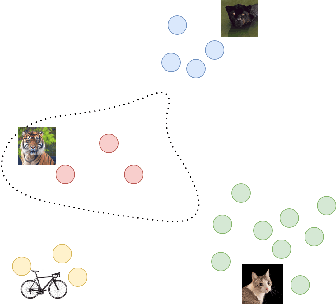
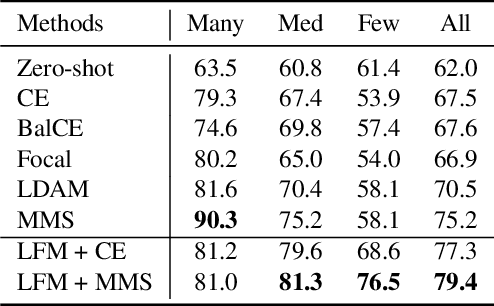
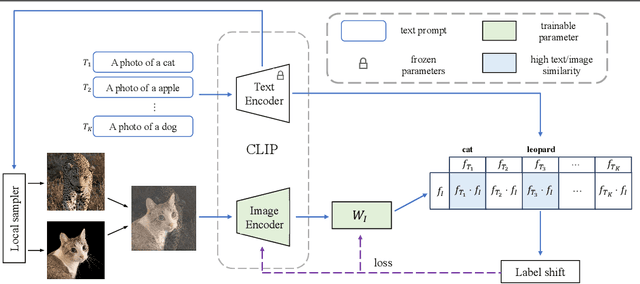
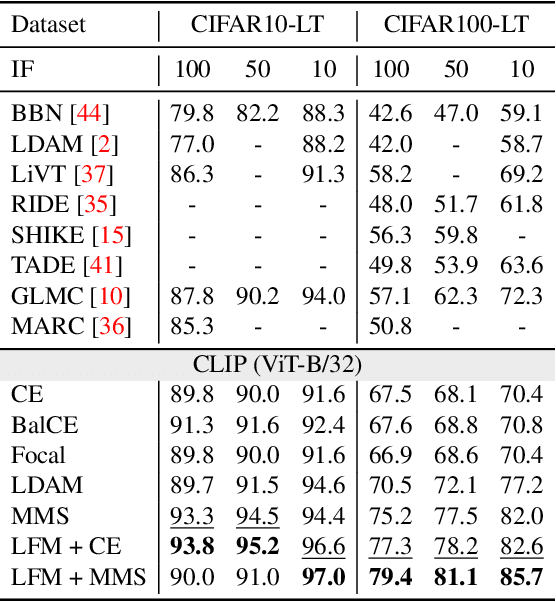
Abstract:In many real-world applications, the frequency distribution of class labels for training data can exhibit a long-tailed distribution, which challenges traditional approaches of training deep neural networks that require heavy amounts of balanced data. Gathering and labeling data to balance out the class label distribution can be both costly and time-consuming. Many existing solutions that enable ensemble learning, re-balancing strategies, or fine-tuning applied to deep neural networks are limited by the inert problem of few class samples across a subset of classes. Recently, vision-language models like CLIP have been observed as effective solutions to zero-shot or few-shot learning by grasping a similarity between vision and language features for image and text pairs. Considering that large pre-trained vision-language models may contain valuable side textual information for minor classes, we propose to leverage text supervision to tackle the challenge of long-tailed learning. Concretely, we propose a novel text-guided mixup technique that takes advantage of the semantic relations between classes recognized by the pre-trained text encoder to help alleviate the long-tailed problem. Our empirical study on benchmark long-tailed tasks demonstrates the effectiveness of our proposal with a theoretical guarantee. Our code is available at https://github.com/rsamf/text-guided-mixup.
SeA: Semantic Adversarial Augmentation for Last Layer Features from Unsupervised Representation Learning
Aug 23, 2024Abstract:Deep features extracted from certain layers of a pre-trained deep model show superior performance over the conventional hand-crafted features. Compared with fine-tuning or linear probing that can explore diverse augmentations, \eg, random crop/flipping, in the original input space, the appropriate augmentations for learning with fixed deep features are more challenging and have been less investigated, which degenerates the performance. To unleash the potential of fixed deep features, we propose a novel semantic adversarial augmentation (SeA) in the feature space for optimization. Concretely, the adversarial direction implied by the gradient will be projected to a subspace spanned by other examples to preserve the semantic information. Then, deep features will be perturbed with the semantic direction, and augmented features will be applied to learn the classifier. Experiments are conducted on $11$ benchmark downstream classification tasks with $4$ popular pre-trained models. Our method is $2\%$ better than the deep features without SeA on average. Moreover, compared to the expensive fine-tuning that is expected to give good performance, SeA shows a comparable performance on $6$ out of $11$ tasks, demonstrating the effectiveness of our proposal in addition to its efficiency. Code is available at \url{https://github.com/idstcv/SeA}.
Online Zero-Shot Classification with CLIP
Aug 23, 2024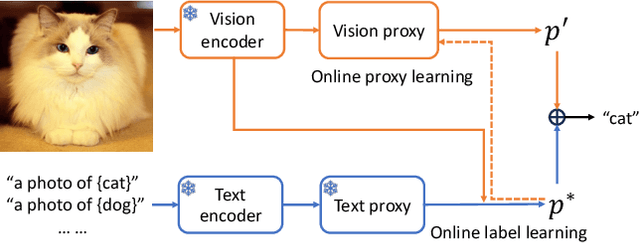
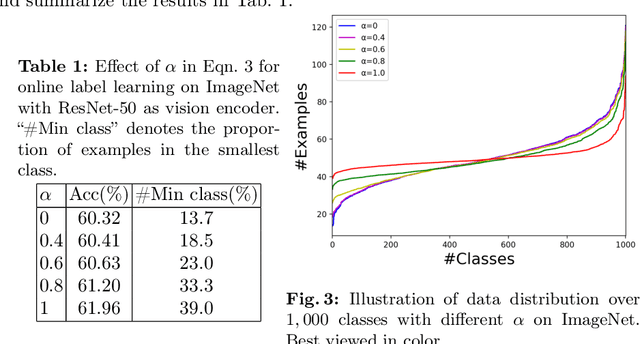


Abstract:Vision-language pre-training such as CLIP enables zero-shot transfer that can classify images according to the candidate class names. While CLIP demonstrates an impressive zero-shot performance on diverse downstream tasks, the distribution from the target data has not been leveraged sufficiently. In this work, we study a novel online zero-shot transfer scenario, where each image arrives in a random order for classification and is visited only once to obtain prediction immediately without storing its representation. Compared with the vanilla zero-shot classification, the proposed framework preserves its flexibility for online service while considering the statistics of the arrived images as the side information to capture the distribution of target data, which can help improve the performance of real-world applications. To tackle the challenge of effective online optimization, we first develop online label learning to model the target data distribution. Then, the proxy of each class in the vision space is further optimized with the proposed online proxy learning method to mitigate the modality gap between images and text. The convergence of both online strategies can be theoretically guaranteed. By combining the predicted label from the online label learning and proxy learning, our online zero-shot transfer method (OnZeta) achieves $78.94\%$ accuracy on ImageNet without accessing the entire data set. Moreover, extensive experiments on other 13 downstream tasks with different vision encoders show a more than $3\%$ improvement on average, which demonstrates the effectiveness of our proposal. Code is available at \url{https://github.com/idstcv/OnZeta}.
Multi-Modal Proxy Learning Towards Personalized Visual Multiple Clustering
Apr 24, 2024Abstract:Multiple clustering has gained significant attention in recent years due to its potential to reveal multiple hidden structures of data from different perspectives. The advent of deep multiple clustering techniques has notably advanced the performance by uncovering complex patterns and relationships within large datasets. However, a major challenge arises as users often do not need all the clusterings that algorithms generate, and figuring out the one needed requires a substantial understanding of each clustering result. Traditionally, aligning a user's brief keyword of interest with the corresponding vision components was challenging, but the emergence of multi-modal and large language models (LLMs) has begun to bridge this gap. In response, given unlabeled target visual data, we propose Multi-MaP, a novel method employing a multi-modal proxy learning process. It leverages CLIP encoders to extract coherent text and image embeddings, with GPT-4 integrating users' interests to formulate effective textual contexts. Moreover, reference word constraint and concept-level constraint are designed to learn the optimal text proxy according to the user's interest. Multi-MaP not only adeptly captures a user's interest via a keyword but also facilitates identifying relevant clusterings. Our extensive experiments show that Multi-MaP consistently outperforms state-of-the-art methods in all benchmark multi-clustering vision tasks. Our code is available at https://github.com/Alexander-Yao/Multi-MaP.
Dual-disentangled Deep Multiple Clustering
Feb 07, 2024Abstract:Multiple clustering has gathered significant attention in recent years due to its potential to reveal multiple hidden structures of the data from different perspectives. Most of multiple clustering methods first derive feature representations by controlling the dissimilarity among them, subsequently employing traditional clustering methods (e.g., k-means) to achieve the final multiple clustering outcomes. However, the learned feature representations can exhibit a weak relevance to the ultimate goal of distinct clustering. Moreover, these features are often not explicitly learned for the purpose of clustering. Therefore, in this paper, we propose a novel Dual-Disentangled deep Multiple Clustering method named DDMC by learning disentangled representations. Specifically, DDMC is achieved by a variational Expectation-Maximization (EM) framework. In the E-step, the disentanglement learning module employs coarse-grained and fine-grained disentangled representations to obtain a more diverse set of latent factors from the data. In the M-step, the cluster assignment module utilizes a cluster objective function to augment the effectiveness of the cluster output. Our extensive experiments demonstrate that DDMC consistently outperforms state-of-the-art methods across seven commonly used tasks. Our code is available at https://github.com/Alexander-Yao/DDMC.
Intra-Modal Proxy Learning for Zero-Shot Visual Categorization with CLIP
Oct 30, 2023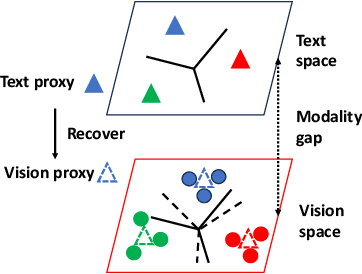



Abstract:Vision-language pre-training methods, e.g., CLIP, demonstrate an impressive zero-shot performance on visual categorizations with the class proxy from the text embedding of the class name. However, the modality gap between the text and vision space can result in a sub-optimal performance. We theoretically show that the gap cannot be reduced sufficiently by minimizing the contrastive loss in CLIP and the optimal proxy for vision tasks may reside only in the vision space. Therefore, given unlabeled target vision data, we propose to learn the vision proxy directly with the help from the text proxy for zero-shot transfer. Moreover, according to our theoretical analysis, strategies are developed to further refine the pseudo label obtained by the text proxy to facilitate the intra-modal proxy learning (InMaP) for vision. Experiments on extensive downstream tasks confirm the effectiveness and efficiency of our proposal. Concretely, InMaP can obtain the vision proxy within one minute on a single GPU while improving the zero-shot accuracy from $77.02\%$ to $80.21\%$ on ImageNet with ViT-L/14@336 pre-trained by CLIP. Code is available at \url{https://github.com/idstcv/InMaP}.
AugDMC: Data Augmentation Guided Deep Multiple Clustering
Jun 22, 2023Abstract:Clustering aims to group similar objects together while separating dissimilar ones apart. Thereafter, structures hidden in data can be identified to help understand data in an unsupervised manner. Traditional clustering methods such as k-means provide only a single clustering for one data set. Deep clustering methods such as auto-encoder based clustering methods have shown a better performance, but still provide a single clustering. However, a given dataset might have multiple clustering structures and each represents a unique perspective of the data. Therefore, some multiple clustering methods have been developed to discover multiple independent structures hidden in data. Although deep multiple clustering methods provide better performance, how to efficiently capture the alternative perspectives in data is still a problem. In this paper, we propose AugDMC, a novel data Augmentation guided Deep Multiple Clustering method, to tackle the challenge. Specifically, AugDMC leverages data augmentations to automatically extract features related to a certain aspect of the data using a self-supervised prototype-based representation learning, where different aspects of the data can be preserved under different data augmentations. Moreover, a stable optimization strategy is proposed to alleviate the unstable problem from different augmentations. Thereafter, multiple clusterings based on different aspects of the data can be obtained. Experimental results on three real-world datasets compared with state-of-the-art methods validate the effectiveness of the proposed method.
 Add to Chrome
Add to Chrome Add to Firefox
Add to Firefox Add to Edge
Add to Edge